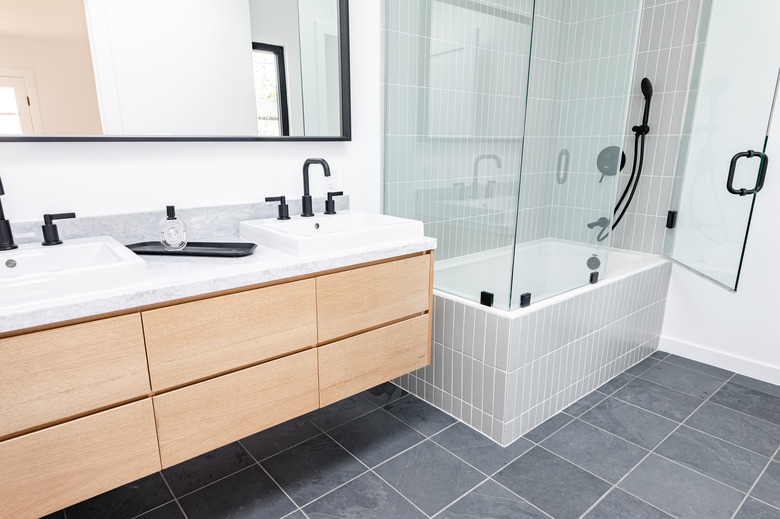Floating Bathroom Vanity: What You Should Know
Let's just cut to the chase — a floating bathroom vanity is the perfect touch for your modern bathroom. Floating vanities are sleek, modern and just plain neat, but they don't work everywhere.
Most floating vanities just don't look right in some bathrooms. If you're going for a quaint, country-cottage feel in your bathroom, for instance, a floating vanity will look out of place. It's important to go beyond looks, however, and weigh all the pros and cons of a floating vanity before you opt for one.
Floating Bathroom Vanity Pros
If you're considering a floating vanity, knowing that it looks cool probably isn't quite enough to sway you. Fortunately, there are lots of other benefits too. One is that you can install it at any height you want. According to the Philadelphia Inquirer, the standard height of a traditional bathroom vanity cabinet is between 30 and 32 inches. You can easily hang a floating vanity at whatever height you choose, however, so you can accommodate the needs of people who are taller or shorter than average.
A floating bathroom vanity also makes cleaning easier. You won't have to try and sweep or mop around the bottom of the vanity where dirt likes to gather. Instead, you can simply run your mop right under the vanity. In addition to easy cleaning, the open space under a floating vanity makes small bathrooms feel bigger and provides a convenient space to store a step stool for children who can't quite reach the vanity yet.
Hopefully, you'll never have to deal with a leaky pipe or a flooded bathroom. If you do, a floating bathroom vanity makes mopping up the water much easier and reduces the risk of damage. Standing water can soak into the toe-kick or wood at the bottom of a traditional vanity and cause it to rot or deteriorate. This isn't a concern with a floating vanity.
Floating Bathroom Vanity Cons
Floating vanities aren't for everyone, and reduced storage space is one reason. Although they do come with cabinets and cupboards, they're a bit shorter than those found on some traditional vanities.
Floating vanities also cost a bit more than their traditional counterparts. According to Fixr, the average cost to buy a traditional bathroom vanity cabinet and have it installed is around $1,200. A floating vanity costs a bit more at around $1,310 to $1,390. This difference seems negligible, but it matters if you're working with a tight budget. Remember too that costs could climb if you need to move plumbing.
It's also important to be honest about your habits when choosing a floating vanity. Do you ever sit your kids on the vanity counter to make brushing their teeth easier for you? Have you ever stood on the vanity countertop rather than a ladder when painting your bathroom ceiling or changing a light bulb? These activities are more dangerous on a floating bathroom vanity since too much weight can pull the vanity off the wall.
Floating Vanity Installation
Installing a floating bathroom vanity is a bit more difficult than installing one that sits on the floor. You can still DIY the project but only if you have some weekend-warrior experience under your belt already. Because the vanity mounts to the wall, it's imperative that it has adequate support. If it is not properly mounted, something as simple as one of your kids leaning on it could pull it out of the wall.
To that end, the first step to installing a floating vanity is to beef up the wall behind it. You'll need to tear open your wall, notch the studs and install a horizontal support beam across them to support the vanity's weight. When you're done, patch the drywall. After patching the wall, you can hang your vanity according to the manufacturer's instructions.
Install the countertop next using the one that came with your vanity. Floating vanities often use solid-surface countertops because it adds structural integrity and rigidity to the vanity, so don't go rogue and use a different counter. After installing the counter, drill the necessary holes for your drain, faucet and water supply lines and then plumb the vanity.
Installing a Floating Vanity Can Get Complicated
If you're building a new home or doing a renovation that completely guts your bathroom, installing a floating vanity is a single project. Things get a bit more complicated, however, if you're tearing out a traditional vanity cabinet and replacing it with a floating unit.
First, you'll need to consider your plumbing, In traditional vanities, it's common for the water supply lines to come up through your floor. This won't do with a floating vanity, so you'll have to move your plumbing so that it comes out of your wall instead. If you're not comfortable moving the plumbing yourself, you may need a plumber for this part of the project.
You'll also need to address potential flooring issues. If your bathroom floor was redone after the vanity was put in, the flooring under the old bathroom vanity set won't match the rest of the room. If you've recently tiled your bathroom floor and have tile left over, you may get away with adding new tile under the new vanity. If not, you may need to redo the entire floor.
References
- The Philadelphia Inquirer: How High Should Bathroom Counters Be?
- Innovate Building Solutions: The Pros and Cons of Wall Hung Floating Vanities You Need to Know
- Reico Kitchen & Bath: The "Flows" and Cons of Floating Vanity Bathroom Cabinets
- Legal Eagle Contractors: 8 Good Reasons to Add a Floting Vanity to Your Bathroom
- Fixr: Wall Hung Vs Floor Mounted Vanity
